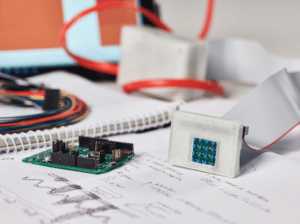The James Dyson Foundation’s 2017 International Winner has been announced. The team of medical and bioengineering undergraduates from McMaster University in Ontario, Canada was chosen for designing The sKan, a low-cost and non-invasive melanoma detection medical device. Watch the video.
“By using widely available and inexpensive components, The sKan allows for melanoma skin cancer detection to be readily accessible to the many,” says James Dyson. “It’s a very clever device with the potential to save lives around the world. This is why I have selected it as this year’s international winner.”
Skin cancer accounts for one in every three cancer diagnoses. The estimated 5-year survival rate for patients whose melanoma is detected early is approximately 98 percent. Current melanoma detection methods either rely on a visual inspection or need a specialist’s opinion which is time consuming and costly. With high numbers of patients needing a rapid diagnosis to begin treatment, the health services are at maximum capacity. The sKan poses a viable solution.
The sKan—designed by Michael Takla, Rotimi Fadiya, Shivad Bhavsar and Prateek Mathur—uses accurate and inexpensive temperature sensors to pinpoint areas of tissue that gain heat quicker than the surrounding area of skin. The results are displayed as a heat map and temperature difference time plot on a regular computer. A medical professional can use the quantitative findings produced by the sKan to indicate whether the patient needs to be referred for further investigation or not.
“We are truly humbled and excited to be given this remarkable opportunity,” says the sKan team, which plans to use the $40,000 prize money to reiterate and refine their design to ensure it passes US Food and Drug Administration’s standards. The university department won $6,000.
There are two James Dyson Award international runners up; each won $6,000. Atropos is a 6-axis 3D printing robotic arm that uses continuous fiber composites material to produce high-performance objects. Designers Gabriele Natale and Michele Tonizzo of Italy hope to tackle the amount of waste produced by current high performance 3D printing tools. Watch the video.
The other runner up, Twistlight, was designed by Tina Zimmer of Germany. It uses LED lights to make veins appear highly contrasted within their surrounding dermal tissue. The light can be used to easily insert needles and catheters into a patient’s skin.
The National Award winners in the United States are:
Cup for Arthritis, Parkinson’s and the Visually Impaired, by Tao An “Andy” Yu of Rhode Island School of Design, won the top spot and $2,500. The prototype would solve the issue of spillage caused by tremors, joint pain and/or poor sight for people with physical disabilities while they are drinking. An organic lid with an easy-to-feel opening, controls the flow of the liquid. The wooden dowel is a visual aid that floats when the cup is full.
Users can tell how much water is in the cup and lift the knob from the raised dowel if needed. The dent lid design makes space for the nose, so users do not have to tilt their head in case of joint pain. The cup includes a weighted bottom which reduces tremors for Parkinson’s patients. Rubber offers friction and shock absorbance when dropped. The cup also has a tapered body for better grip and rounded lip for easier pouring and a more comfortable drinking experience. An optional coaster with a magnet keeps the cup stable. “Available products are designed for medical equipment instead of daily use,” describes Yu. “The most important part of designing for disabilities is understanding the dignity factor: the need for help without giving up living norms.”
There are four runners-up:
Fibrefree by Charles Kepper of Syracuse University is a microfiber trapping laundry ball that serves three functions: combating catastrophic pollution caused by washing synthetic clothing; replacing dryer sheets; and reducing drying time and energy. “I think some of the best inspiration comes from nature. It so elegantly evolves to solve its problems, and one can apply nature’s wisdom to any number of designs to make them better,” says Kepper.
Peris, by Artin Perse of New York University, is a secure and affordable pill bottle that only dispenses the prescribed dose at the prescribed time. “With more than 60 people dying everyday in the United States from a prescription opioid overdose, our product significantly reduces the risk of opioid misuse and overdose,” says Perse.
Strada, was designed by Jack Koby, who served as an IDSA Student Chapter officer at the University of Oregon. It provides increased stability, improves posture and reduces back pain and wrist strain for elderly people. These benefits are the result of Strada’s upright design and forearm supports, and the centered position of the user.
Thomy, by Renata Souza Luque of Parsons, is an insulin kit for children with Type 1 diabetes. The set contains temporary tattoos that allow children to remember where they have previously injected the insulin and an insulin pen designed specifically for a child’s hand. “Born and raised in Mexico, I believe that exposure to different cultures strengthens artists’ skills to recognize design opportunities,” says Luque.
“Design something that solves a problem,” encouraged organizers. “We’re looking for designers who think differently to create products that work better.”
